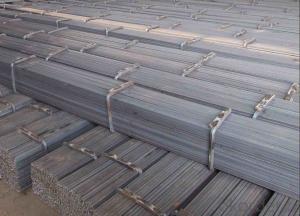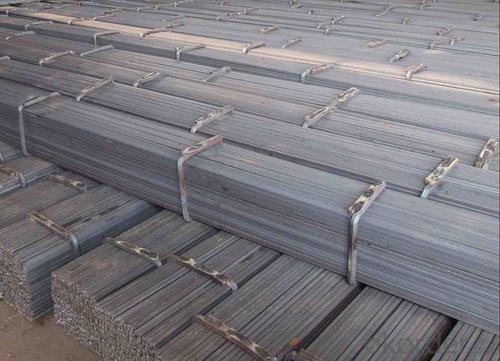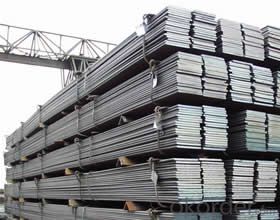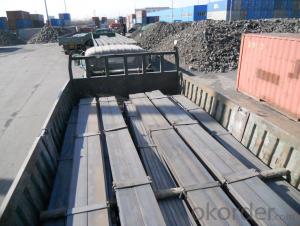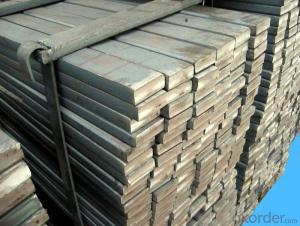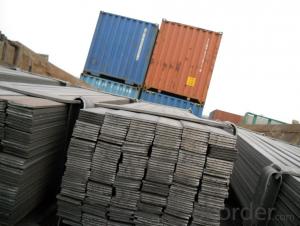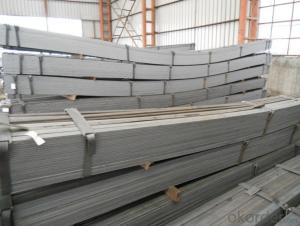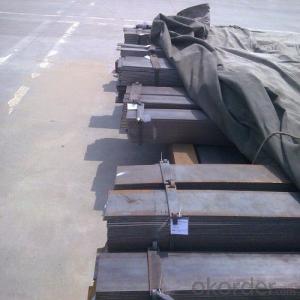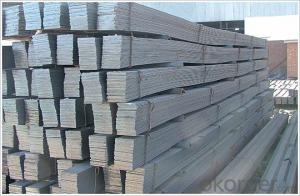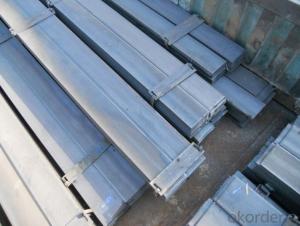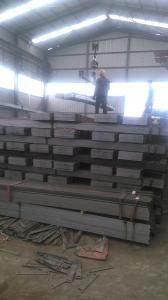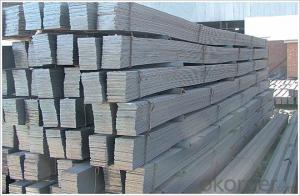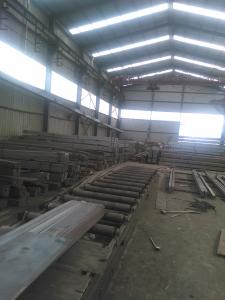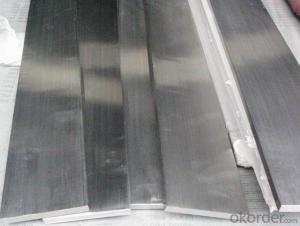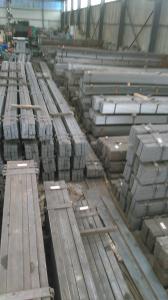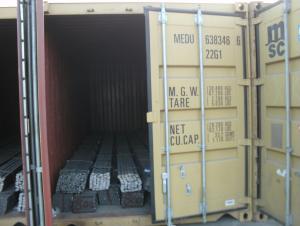Flat Bar Hot Rolled High Quality GB Q235
- Loading Port:
- Tianjin
- Payment Terms:
- TT or LC
- Min Order Qty:
- 25 m.t.
- Supply Capability:
- 200000 m.t./month
OKorder Service Pledge
OKorder Financial Service
You Might Also Like
Product Applications:
Hot Rolled Steel I-Beams are ideal for structural applications and are widely used in the construction of buildings and bridges, and the manufacturing, petrochemical, and transportation industries.
Product Advantages:
OKorder's Steel I-Beams are durable, strong, and resist corrosion.
Main Product Features:
· Premium quality
· Prompt delivery & seaworthy packing (30 days after receiving deposit)
· Corrosion resistance
· Can be recycled and reused
· Mill test certification
· Professional Service
· Competitive pricing
Product Specifications:
Manufacture: Hot rolled
Grade: Q195 – 235
Certificates: ISO, SGS, BV, CIQ
Length: 6m – 12m, as per customer request
Packaging: Export packing, nude packing, bundled
Commodity: Mild Steel Flat Bar Standard: GB;JIS Material: Q195-235;SS400 Brand name: FLATSPACE Origin place: China Thickness: 3mm-30mm Width:20mm-200mm Length: Max 12m Certification: SGS/BV Chemical composition of Q235
Physical properties of Q235
| ||||||||||||||||||||||||||||||||||||||||||||||||||||||||||||||||||||||||||
FAQ:
Q1: How soon can we receive the product after purchase?
A1: Within three days of placing an order, we will begin production. The specific shipping date is dependent upon international and government factors, but is typically 7 to 10 workdays.
Q2: What makes stainless steel stainless?
A2: Stainless steel must contain at least 10.5 % chromium. It is this element that reacts with the oxygen in the air to form a complex chrome-oxide surface layer that is invisible but strong enough to prevent further oxygen from "staining" (rusting) the surface. Higher levels of chromium and the addition of other alloying elements such as nickel and molybdenum enhance this surface layer and improve the corrosion resistance of the stainless material.
Q3: Can stainless steel rust?
A3: Stainless does not "rust" as you think of regular steel rusting with a red oxide on the surface that flakes off. If you see red rust it is probably due to some iron particles that have contaminated the surface of the stainless steel and it is these iron particles that are rusting. Look at the source of the rusting and see if you can remove it from the surface.
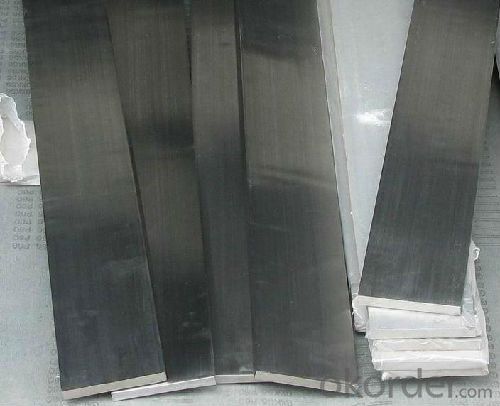
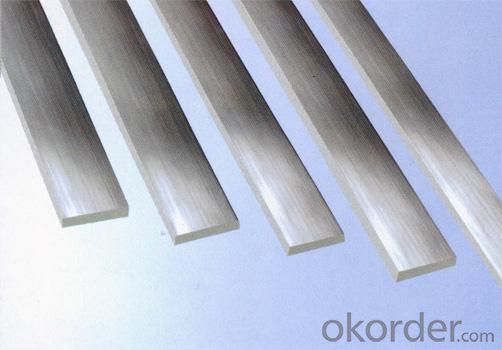
- Q: Friction coefficient of steel pipe and flat steel on roller table!
- Flat, refers to the width 12-300mm, thickness 4-60mm, cross section is rectangular in shape and with a blunt edge of steel. Flat steel can be finished steel, or can be used as the blank of welded pipe and thin slab for laminated sheet rolling. Main application: flat steel is used as a material, used for making iron, tools and machinery parts, and used as frame structures and escalators for buildings.
- Q: Are steel flat bars suitable for agricultural equipment?
- Yes, steel flat bars are suitable for agricultural equipment. They are known for their strength, durability, and versatility, making them an ideal choice for various applications in the agricultural sector. Steel flat bars can be used in the construction of frames, brackets, supports, and other components of agricultural machinery and equipment, providing stability and structural integrity. Additionally, steel's resistance to corrosion and wear ensures that the equipment can withstand the harsh conditions often encountered in agricultural settings.
- Q: What is 40x4 galvanized flat steel, please?
- Refers to the galvanized flat steel, width 12-300mm, thickness 4-60mm, cross section is rectangular and with pure edge of galvanized steel. Galvanized flat steel can be finished steel, also can be galvanized pipe blank and galvanized belt.
- Q: Are steel flat bars magnetic?
- Indeed, steel flat bars generally possess magnetic properties. Steel, being primarily composed of iron, is inherently magnetic. Consequently, when iron is combined with various other components to create steel, the resultant substance maintains its magnetic characteristics. Consequently, steel flat bars have an affinity for magnets and can be employed in sectors necessitating magnetic attributes, including industrial machinery, construction, and manufacturing.
- Q: What are the different methods of polishing steel flat bars?
- There are several different methods that can be used to polish steel flat bars, depending on the desired finish and level of polish required. One common method is by using sandpaper or abrasive pads. This involves using progressively finer grits of sandpaper or abrasive pads to remove any imperfections or roughness on the surface of the steel. Starting with a coarser grit, such as 80 or 120, and gradually moving to finer grits, such as 400 or 600, will help achieve a smooth and polished finish. This method can be done by hand or with the use of a power tool, such as a sander or grinder. Another method is by using polishing compounds. Polishing compounds are abrasive substances that are applied to the steel surface and then buffed with a cloth or polishing wheel. These compounds help to remove scratches, oxidation, and other imperfections, leaving a shiny and polished surface. Different polishing compounds are available, ranging from coarse to fine, depending on the level of polishing required. Electropolishing is another method that can be used to polish steel flat bars. This is an electrochemical process that removes a thin layer of material from the surface of the steel, resulting in a smooth and polished finish. The steel flat bar is submerged in an electrolyte solution and an electric current is applied, which causes the material to dissolve and the surface to become polished. Electropolishing is often used for stainless steel flat bars and can be an effective method for achieving a high-quality and uniform finish. In addition to these methods, there are also mechanical polishing techniques that can be used, such as using a polishing wheel or a buffing machine. These machines have rotating wheels or pads that are coated with abrasive compounds and are used to buff and polish the steel surface. The speed and pressure applied can be adjusted to achieve the desired level of polish. Overall, the choice of method for polishing steel flat bars depends on factors such as the desired finish, the level of polish required, and the equipment and materials available. It is important to consider these factors and select the most appropriate method to achieve the desired results.
- Q: Can steel flat bars be used for making window frames or door frames?
- Window frames or door frames can indeed be made using steel flat bars. Steel flat bars possess remarkable strength, durability, and exceptional structural properties, rendering them an optimal selection for frame construction. They furnish windows or doors with stability and support, guaranteeing their enduring functionality. Moreover, steel flat bars can be effortlessly welded, cut, and molded to accommodate precise measurements and designs, presenting opportunities for customization and adaptability in frame assembly. All in all, steel flat bars represent a dependable and pragmatic material for fabricating window frames or door frames.
- Q: Are steel flat bars suitable for manufacturing machinery components?
- Indeed, steel flat bars prove to be a fitting option for fabricating machinery components. Their utility extends across diverse sectors within the manufacturing industry. Renowned for their robustness, potency, and ability to withstand deterioration, steel flat bars can be effortlessly manipulated, fused, and molded into an assortment of dimensions and contours, rendering them an optimal choice for crafting machinery components. Furthermore, these bars exhibit exceptional structural integrity and can endure substantial burdens, thereby solidifying their reputation as a dependable selection for manufacturing machinery components that necessitate both fortitude and steadiness.
- Q: What are the different types of surface finishes for aluminum steel flat bars?
- When selecting a surface finish for aluminum steel flat bars, it is crucial to take into account the specific needs of your application as well as the desired visual appearance. There are several options available: 1. Mill Finish: This is the standard finish applied to aluminum steel flat bars directly from the mill. It has an untreated, natural look and a slightly rough texture. 2. Anodized Finish: By employing an electrochemical process, an anodized finish forms a protective layer on the surface of the aluminum steel flat bars. This finish not only enhances corrosion resistance but can also be dyed in various colors. 3. Polished Finish: Achieved through mechanical smoothing, a polished finish produces a reflective and glossy appearance on the surface of the aluminum steel flat bars. This finish is often chosen for decorative purposes, enhancing the metal's aesthetic appeal. 4. Brushed Finish: The brushing process involves using fine abrasive pads or brushes to create a textured surface on the aluminum steel flat bars. This finish gives the metal a satin-like look and helps to conceal scratches and fingerprints. 5. Powder Coated Finish: In this method, a dry powder is applied to the surface of the aluminum steel flat bars, then baked to create a durable and protective coating. Powder coating offers a wide range of colors and excellent resistance to wear, weather, and chemicals. 6. Painted Finish: Painting is a popular surface finish for aluminum steel flat bars, particularly when specific colors or patterns are desired. Paint can be applied in various ways, such as spraying or dipping, and provides an additional layer of corrosion protection. It is crucial to carefully consider the specific requirements of your application and the desired visual effects when selecting the appropriate surface finish for aluminum steel flat bars.
- Q: What is the minimum width of a steel flat bar?
- The specific requirements and standards set by the industry or application can cause the minimum width of a steel flat bar to vary. Typically, the minimum width is around 1/8 inch (3.175 mm). However, it is crucial to consider the specific use case, as certain applications may necessitate narrower or wider flat bars. Moreover, various manufacturers may have their own minimum width specifications for steel flat bars. Consequently, it is advisable to refer to the relevant industry standards or manufacturer guidelines for the specific minimum width requirement in a particular context.
- Q: Are steel flat bars used in the manufacturing of appliances?
- Yes, steel flat bars are commonly used in the manufacturing of appliances. Steel is a durable and strong material that offers excellent structural integrity, making it ideal for appliances that require stability and support. Steel flat bars are often used in the construction of appliance frames, brackets, and structural components. They provide a solid foundation for various appliance parts and help ensure the longevity and reliability of the finished product. Additionally, steel flat bars can be easily shaped and welded, allowing manufacturers to create customized designs and configurations to suit specific appliance requirements.
Send your message to us
Flat Bar Hot Rolled High Quality GB Q235
- Loading Port:
- Tianjin
- Payment Terms:
- TT or LC
- Min Order Qty:
- 25 m.t.
- Supply Capability:
- 200000 m.t./month
OKorder Service Pledge
OKorder Financial Service
Similar products
Hot products
Hot Searches
Related keywords
